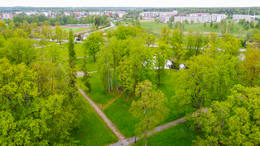Division
A division (from Latin divisio, "partition") is a large military unit consisting of several regiments or brigades, and consisting of 10,000 to 30,000 soldiers. Several divisions can be combined into a corps. The division of troops into divisions arose as the warring states increased the size of their troops. The first divisions were created in France in the 17th century.
Divisions in the Latvian Armed Forces began to be formed after the Battle of Cēsis in July 1919, when a unified army was formed. The divisions were named after historical regions of Latvia. In mid-July, the Latvian Separate or South Latvia Brigade and the North Latvia Brigade were expanded into the Kurzeme and Vidzeme divisions, leaving their previous commanders, Colonel Jānis Balodis and Colonel Jorģis Zemitāns. A little later, the organization of the third — Latgale Division began, the command of which was assigned to the former commander of the 2nd Cēsis Infantry Regiment, Lieutenant Colonel Krišjānis Berķis. By the order of the Commander-in-Chief of the Army of July 15, a unified structure and staff were determined for the army units: three infantry regiments in each division. During the Bermontiad in December 1919, the -4. The Zemgale Division, whose command was entrusted to Colonel Oskars Dankers. Each infantry division also included an artillery regiment.
The Technical Division of the Latvian Army was established in January 1922. It was a collection of various military technical units and was commanded by General Jānis Kurelis throughout the division's existence until 1940.
More information sources
Sources used:
Latvian Armed Forces. Wikipedia. https://lv.wikipedia.org/wiki/Latvijas_Bru%C5%86otie_sp%C4%93ki
Juris Ciganovs. Summer of 1919 – the creation of a unified Latvian army. SARGS.LV August 10, 2016. https://www.sargs.lv/lv/latvijas-neatkaribas-kars/2016-08-10/1919-gada-vasara-vienotas-latvijas-armijas-izveidosana
Related objects
Latvian Military Aviation Airport
Located in the territory of Vecgulbene Manor - in the historical center.
In the interwar period, Gulbene was home to a Latvian army garrison, where the 7th Sigulda Infantry Regiment battalion was stationed. In the mid-1930s, the creation of a military aviation base began, because for the successful operation of military aviation, an extensive network of airfields must be ensured even in peacetime. Airfields are especially important in places where important railway and road junctions have been established. On November 11, 1935, construction of a military airfield began here. In 1937, a newly formed Aviation Regiment unit was stationed in Gulbene, which became the 6th reconnaissance squadron of the Latgale Division, increasing the number of army units near the eastern border of Latvia.
The Orangery building is visible.
Latvian Army Summer Camp in Litene
The Latvian Army Summer Camp in Litene is located in the forest in Litene parish, near the Pededze River. The beginnings of the Litene Camp can be traced back to 1935 when the construction of a summer camp complex for the Latgale division of the Latvian Army was started. From May to autumn, several thousand soldiers learned combat tactics and shooting skills in Litene. In the summer of 1941, Latvian Army officers were arrested by Red Army and NKVD troops at an army summer camp in Litene. Several officers were shot on the spot, while others were deported to Siberia. On 14 June 1941, at least 430 officers were arrested and deported to Siberia in the Litene and Ostrovieši camps about 10 kilometres from Litene. The only historical building that has survived from the camp is a food storage facility. Only the foundations remain from the other buildings. There is a viewing platform with the Latvian flag, benches and a well-maintained place for a fire. A demilitarised cannon was installed with the support of the Ministry of Defence and the National Armed Forces. Information boards are in place. The Wall of Pain memorial in the Litene graveyard is also connected with the events at the Litene camp. The YouTube channel of the Latvian Army features a video named ‘Litene, Katyn of the Latvian Army’.





